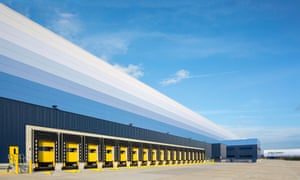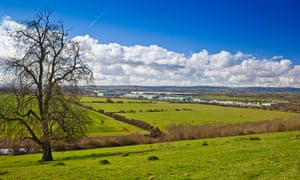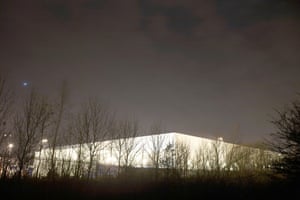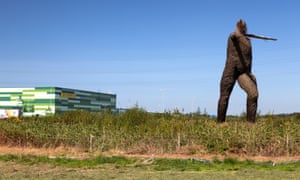The only problem is that we need huge amounts of warehousing and 'distribution centres':
Futures Forum: An 'inter-modal freight depot' by any other name >>> also known as: a giant Lidl's warehouse on the M5
Futures Forum: The promises from the Skypark 'business park' >>> "A multinational comes along and plonks itself just out of town. Hooray, they tell us... Jobs for all!"
Futures Forum: BREAKING NEWS >>> Sidford business park > Fords planning application >>> 16/0669/MOUT >>> REFUSED
Whilst politicians love it:
Futures Forum: "Regeneration and economic development" in East Devon >>> looking beyond the conventional, the ideological and the heavyhanded
... it doesn't actually help the health of our town centres:
Futures Forum: How to revive the health of high streets > focus on bringing back jobs and leisure activity to town centres
The Observer looks at the phenomenon:
A shed the size of a town: what Britain’s giant distribution centres tell us about modern life
Designed to disappear into the landscape, Britain’s vast super-warehouses also reflect a world in which we expect online purchases to arrive as if by magic
When you click on a product, something, somewhere, moves. The item is shifted off its shelf by human or robot and on to a chain of delivery mechanisms that takes it to your door. That item, and millions others like it, plus the machinery that handles them, needs space. The more we shop online, the more such space is needed.
You’ll know all this, I expect, but you may only be dimly aware of the physical consequences: very big boxes, getting bigger and more numerous. Higher, too, as robotic distribution systems allow goods to be piled further from the ground than before.
These boxes are of such importance that some are classed as “nationally significant infrastructure projects”, which means that national government rather than local authorities give them planning permission. Some are shrouded in secrecy. They are where the virtual becomes physical, with a vengeance. Their scale challenges the conventions of town and country planning, pushing their designers and creators to find more or less convincing ways to respond.
Imagine the space that is used to store and display a product in a traditional shop, and then imagine great dollops of it sucked from almost every high street and supermarket in the land to a centralised facility. Add it to the long-established need for physical shops to warehouse their goods. You end up with something like Dirft – the Daventry International Rail Freight Terminal – near Rugby, or the Magna Parks in Milton Keynes and Lutterworth: town-sized agglomerations, containing thousands of workers, made up of very big sheds. They are called distribution centres, which differ from what used to be called warehouses in the degree to which the buildings are integrated into logistical networks of trucks, trains, the internet and subsidiary distribution points.
Dirft and the Magna Parks are within what, with unexpected romance, is called the “golden triangle”, a land of sheds, roads and marketing gerunds (such as Eddie Stobart’s “delivering sustainable distribution”) laid over the fields and towns of old England. In some accounts the triangle’s points are Leicester, Coventry and Milton Keynes and in others its sides are the M1, M6 and M42 motorways, but in either case it describes an area from where 85% of the population of Great Britain can be reached in four and a half hours, which is the maximum time an HGV driver can travel without taking a break. In other words, if you order a set of John Lewis bathroom towels in Southampton, Cardiff or Manchester, it will come from the same big box in Milton Keynes.
The Dutch architect Rem Koolhaas argues that the modern countryside is now divided into two types: on the one hand industrialised agriculture with the big structures that serve it, on the other landscapes preserved for their picturesque beauty. Dirft confirms his point. It stands close to the pretty Northamptonshire village of Crick, with its medieval church of St Margaret’s (Grade I listed, notable Romanesque font), also to the pleasant rolling countryside of Warwickshire (Shakespeare’s county, as the sign on the border says). Dirft itself consists of colossal distribution centres from which retailers dispatch their produce, via the nearby M1, across the country. Here is an abstracted high street of the nation in which the buyable contents of a home – food, furnishings, hardware, clothes – are translated into vast labelled containers: Tesco, Sainsburys, Bathstore, Halfords.
Dirft is no prettier than its name and doesn’t claim to be so. It is a landscape of those mute boxes and of the roads, loading areas and parking zones they need to sustain them, the earth vigorously reshaped to make the flat platforms on which they stand. It is made of fences, berms and security gates, of young trees in their protective tubes and gnarled old ones, survivors of the site’s former rural life. A pitched-roofed Ibis hotel adds a note of forlorn domesticity. Wind turbines turn.The Dirft development’s origins lie in the mid-90s, when a freight rail connection was established, via Felixstowe docks and the then new Channel tunnel, into something called the Trans-European Transport Network. As the area had already been designated, in 1978, as a “motorway orientated growth point” the addition of the railport made it exceptionally fertile ground for the bumper crops of big sheds that then started to blossom there. There are now more than 6m sq ft of building with another 7.7m on the way.
You couldn’t call it country or town: it is a node, a zone. It approaches a sort of sublime, you could say, in which the vast whiteish rectangles resemble conceptual art and the engineered terrain unwittingly becomes land art. Its scale is that of the national and international networks of which it is part, not the locality.
The complex is surprisingly uncontentious, given its size and impact, among the local community. “It is positive”, says Josie Flavell of Crick parish council “in that a number of residents are employed by the many companies at Dirft.” She is pleased that Prologis, the company that owns the site, contributes towards two police community support officers, organises litter removal, pays for cycling and pedestrian routes and financed a heritage board to be placed at the site of the old Kilsby and Crick railway.
Simon Bowers, of Daventry district council, also likes the jobs it brings. “It’s a valued part of the local economy,” he says. “It’s an appropriate development that does no real harm.”
But, in a country where land is as constrained as in Britain, where it is a struggle to find space for other such essentials as new housing, the growth of big sheds is particularly hard to accommodate. If it is a fast-moving business, wherein a building 10 times the volume of St Paul’s Cathedral might go up in six months, it might take a decade to assemble a site out of former farmland, and win planning permission for it. In Lutterworth there is a campaign group called Magna Park Is Big Enough, which in January persuaded the local council to refuse, by a margin of two votes, a planned expansion. One meeting of the group was held in a hangar to accommodate the number of protesters.
There is, therefore, a motivation to “innovate in a mindful and respectful way”, as Gazeley, owner of the Magna Parks, put it. Last year Creative Review magazine spotted a trend, a “new breed of superstructures trying very hard to disappear”. Off the M5, for example, near Bridgwater in Somerset, a huge Morrisons distribution centre is clad in long horizontal strips of varying shades of green, the better to blend with the lush West Country landscape. Magna Park in Milton Keynes, home to John Lewis, Waitrose and River Island, a mile-plus-long, 4m sq ft array, is uniformly banded with gradations of blue, from dark at the bottom to pale at the top. The intention is that it will fade into the sky.
It depends on the location, explains Tim Ward of Chetwoods, the architects of the Milton Keynes Magna Park and a number of other distribution centres. If the structures are generally viewed with landscape behind, green works well; if sky, blue is better. There is, he says, some art to the choice of tones that includes a knowledge of the latest developments in the technology of colour.
Chetwoods are keen to stress that they don’t want the structures to disappear, exactly – a futile task, given the enormous size of the buildings – but rather to be less intrusive. Indeed, you are conscious of Magna Park Milton Keynes from miles around – an insistent, astounding, blueish presence that occupies the horizon from end to end, an alternative atmospheric that keeps reappearing down country lanes, from new housing estates and across fields. Or, if you are driving along the M1, it is an azure-cerulean abstraction, flipping past the edge of vision for an appreciable interval of time.
The striking thing about it is less the breaking-up of its bulk than the consistency of the pattern across such an expanse of surface. There may never before have been so much synthetic blueness in one place.
Colour, in any case, only gets you so far. Gazeley like to talk of the million trees they have planted at Lutterworth to create a publicly accessible “Magna Wood” and “the wildlife-rich Mere Lane Lagoon fishing lake.” At Milton Keynes a pond captures and attenuates the rainwater that falls on the development’s expanses of roof. There are swans, moorhens and many species of tree. There is a “bee hotel”. There is an uplifting, if artistically dubious, statue of the Olympic long jumper Greg Rutherford on the roundabout at the entrance to the complex. As befits the home of Waitrose, Magna Park has a palpable quality and coherence in its layout, but even blunt Dirft has measures to buffer its impact with landscape.
Gazeley are particularly proud of Altitude, a new distribution centre on their Milton Keynes site that is not only an unusually high 21 metres but also has a roof ready to be covered by photovoltaic cells, at such time as they become economically viable. The health and wellbeing of employees will be supported by such things as good lighting and ventilation and reindeer moss growing on living walls inside the building. New technology is reducing the number of jobs in the business, I’m told, but many of those that remain are becoming more skilled, which means that companies have to try harder to attract good staff.
Laurie Chetwood of Chetwoods says that distribution centres, which are among the most single-minded of building types, must now acquire a “duality of purpose”, which means things such as making running tracks out of the fire engine lanes that surround the boxes. He talks of cladding that can double as batteries to store solar energy gathered on the roof. One day, maybe, it might be possible to charge electric trucks with it, which would mitigate the rather obvious ecological drawbacks of dispatching thousands of HGVs across the country every day.
Simple as they may look, distribution centres are sophisticated structures. The machinery that moves stuff around is constantly evolving. Their playing field-sized floors have to be exceptionally level, as small unevenness could cause the high fork-lift trucks they use to lean unacceptably at the top. Years of competition have made their structure as spare and economical as can be. Architects such as Chetwoods have to reconcile all this with the wishes of users (who might want something tailored to their needs) and of investors, who will want a structure to be adaptable to future users.
It is tempting to say that these buildings make the internet visible, except that their visibility is strictly limited. Sometimes they get into the news when reporters, posing as warehouse workers, bring news of working conditions inside. You can get a glimmer on Google, for example from employee reviews of Primark’s warehouse, which sits like an acropolis on a raised earthwork in Northamptonshire: “they’re treating a people like nothing,” says one in imperfect English; “they beautiful lied on induction how much they cares about worker, don’t believe them.” The buildings, however, remain notably blank, giving almost no clue of their busy inner lives.
Some users and owners are dismissive of press inquiries to a degree unusual in big, public relations-conscious companies. Tesco refused a request to see inside their Dirft base, which was possibly not surprising, but also to answer simple questions, such as: what are its dimensions?
For the writer Carolyn Steel, whose book Hungry City: How Food Shapes Our Lives examines the relationship of society to food, this secrecy is the antithesis of the more public processes by which food once progressed from field to market to kitchen to plate. “The exchange of food used to bring people together,” she says. “Now the process is designed to exclude the human”. But distribution centres manifest the world we have chosen and had chosen for us, in return for efficiency and convenience, in which a product appears in the home by ever more inscrutable magic.
Their scale and growth are a consequence of the fact that all that physicality and volume that the virtual world displaces has to go somewhere. It’s welcome that architects and developers should try to make something of them and to mitigate their impact with woods, ponds and indeed coloured bands. But, short of a dramatic restructuring of the economic, technical and social basis of the modern world, these uncompromising building types will only become more essential to our lives. The contrast between what was previously thought of as natural and urban landscape will only become more stark.
.
.
.






No comments:
Post a Comment